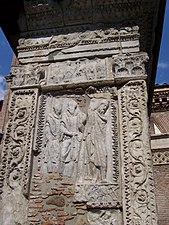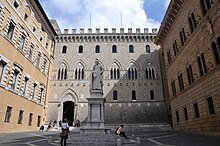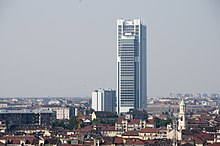Banking in Italy

There are three main types of credit institutions and banks in Italy. Commercial banks, which include three national banks, chartered banks, cooperative banks, and private banks across the country, are the most common.
However, savings banks organized on a provincial or regional basis in addition to investment institutions that issue bonds and provide medium- and long-term credit for public works and agriculture provide additional financial services.[1]
Unicredit is one of the largest banks in Europe by capitalization and Assicurazioni Generali is the seventh largest bank in the world by total assets.
History

The Etruscans and the early Romans did not have true minted coinage for many centuries. Debt and debt bondage, however, were probably rife. Wealthy landowners would make an "advance loan" of seed, foodstuffs or other essentials to tenants, clients and smallholders, in return for a promise of labour services or a substantial share of the crop. The terms of such "loans" compelled defaulters to sell themselves, or their dependants, to their creditor; or, if smallholders, to surrender their farm. Wealthy aristocratic Etruscan and Roman landholders thus acquired additional farms and service for very little outlay.[5] It has been argued that this loan system can be considered an embryonic version of banking as practiced in antiquity.
With the eventual expansion of Roman monetization, a variety of officials came to be associated with banking in ancient Rome. These were the argentarii, mensarii, coactores, and nummulari; many of these roles were derived from Etruscan practices. The argentarii were money changers. The role of the mensarii was to help people through economic hardships, the coactores were hired to collect money and give it to their employer, and the nummulari minted and tested currency. They offered credit systems and loans. Between 260 and the fourth century CE Roman bankers disappear from the historical record, likely because of economic difficulties caused by the debasement of the currency.

The origins of modern banking can be traced to the medieval and early Italian Renaissance, to the rich cities in the north like Florence, Lucca, Siena, Venice, and Genoa. The Bardi and Peruzzi families dominated banking in 14th-century Florence, establishing branches in many other parts of Europe.[6]
One of the most famous Italian banks was the Medici Bank, set up by Giovanni di Bicci de' Medici in 1397.[7] The earliest known state deposit bank, Banco di San Giorgio (Bank of St. George), was founded in 1407 in Genoa, Italy,[8] while Banca Monte dei Paschi di Siena, founded in 1472, is the oldest surviving bank in the world.
In 1893, following the Banca Romana scandal, the Italian government formed the Bank of Italy, the nation's first central bank, as part of massive reforms to the banking sector.[9]
List of banks by total assets

Italy had 11 banking groups (excluding banking group that owned by foreign banks) that were supervised by the European Central Bank directly. According to Mediobanca, the overall number of banks and credits institutions in Italy stands at 439 in 2022, which is a sharp decrease from the 740 that were operating in 2011.[10]
However, ECB considered ICCREA Banca, the clearing house of Italian cooperative banks federation as one banking group, which the publication of Mediobanca considered the cooperative banks are individual entities, such as Banca di Credito Cooperativo di Roma was ranked 22nd in the publication, while ICCREA Banca and Bank of Italy were excluded from the publication.
The following is a list of the main Italian banks ranked by total assets and risk-weighted assets.
- As of December 2022[10]
| Rank (by Mediobanca) | Company | Total Assets (billion €) | RWAs (thousands €) | Type |
|---|---|---|---|---|
| Intesa Sanpaolo | domestic systemically important bank;[11] supervised by European Central Bank[12] | |||
| UniCredit | global systemically important bank (Bucket 1) identified by Financial Stability Board;[13] supervised by European Central Bank[12] | |||
| * | Bank of Italy | central bank | ||
| Cassa Depositi e Prestiti | national investment bank, majority owned by the Ministry of Economy and Finance | |||
| * | BancoPosta division of Poste italiane | joint-control by Cassa Depositi e Prestiti and the Ministry of Economy and Finance | ||
| * | Istituto per il Credito Sportivo | a subsidiary of the Ministry of Economy and Finance | ||
| Banco BPM | domestic systemically important bank;[11] supervised by European Central Bank[12] | |||
| BPER Banca | supervised by European Central Bank[12] | |||
| Banca Monte dei Paschi di Siena | domestic systemically important bank;[11] supervised by European Central Bank,[12] minority owned by Ministry of Economy and Finance (legacy of the 2017 bailout) | |||
| Banca Nazionale del Lavoro | subsidiary of BNP Paribas | |||
| Mediobanca | supervised by European Central Bank[12] | |||
| Crédit Agricole Italia | subsidiary of Crédit Agricole | |||
| 10 | Banca Mediolanum | Also an leading insurance company, supervised by European Central Bank | ||
| 11 | Credito Emiliano | supervised by European Central Bank[12] | ||
| 12 | Banca Popolare di Sondrio | supervised by European Central Bank[12] | ||
| * | ICCREA Banca | clearing house owned by 300+ regional banks, supervised by European Central Bank[12] | ||
| 13 | Deutsche Bank (Italy) | subsidiary of Deutsche Bank AG | ||
| 14 | Banco di Desio e della Brianza | |||
| 15 | Banca Sella Group | |||
| 16 | Banca di Credito Cooperativo di Roma | Will be part of ICCREA Banca Group as shareholder | ||
| 17 | Cassa di Risparmio di Asti |
- Note: Banks with assets less than €10 billion were omitted from this wiki list. Barclays Bank, Italian branch was also excluded
See also
References
- ^ "Overview of Banks in Italy". Corporate Finance Institute.
- ^ Fischer, Julia C. (26 July 2019). Art in Rome: From Antiquity to the Present. Cambridge Scholars Publishing. pp. 98–100. ISBN 978-1-5275-3752-1. Archived from the original on 2022-09-12. Retrieved 2022-08-05.
- ^ Aicher, Peter J. (2004). Rome Alive: A Source-Guide to the Ancient City Volume II (in Latin). Bolchazy-Carducci Publishers. p. 157. ISBN 978-0-86516-507-6. Archived from the original on 2022-09-12. Retrieved 2022-08-05.
- ^ Elsner, Jaś (2005). "Sacrifice and narrative on the Arch of the Argentarii at Rome". Journal of Roman Archaeology. 18: 83–98. doi:10.1017/S1047759400007224. S2CID 188993120.
- ^ See discussion in Cornell, pp. 281–283
- ^ Hoggson, N. F. (1926) Banking Through the Ages, New York, Dodd, Mead & Company.
- ^ Goldthwaite, R. A. (1995) Banks, Places and Entrepreneurs in Renaissance Florence, Aldershot, Hampshire, Great Britain, Variorum
- ^ Macesich, George (30 June 2000). "Central Banking: The Early Years: Other Early Banks". Issues in Money and Banking. Westport, Connecticut: Praeger Publishers (Greenwood Publishing Group). p. 42. ISBN 978-0-275-96777-2. Retrieved 2009-03-12.
The first state deposit bank was the Bank of St. George in Genoa, which was established in 1407.
- ^ Gigliobianco, Alfredo; Giordano, Claire. "No. 5 - Economic Theory and Banking Regulation: The Italian Case (1861-1930s)". Retrieved 5 August 2021.
- ^ a b "Largest Italian banks in 2020, by total assets". September 2021. Retrieved 20 December 2023.
- ^ a b c "Identification of the UniCredit, Intesa Sanpaolo, Banco BPM and Monte dei Paschi di Siena banking groups" (Press release). Bank of Italy. 30 November 2017. Retrieved 14 November 2018.
- ^ a b c d e f g h i "List of supervised entities" (PDF). European Central Bank. 1 January 2023. pp. 12–. Retrieved 20 December 2023.
- ^ "2017 list of global systemically important banks (G-SIBs)" (Press release). Financial Stability Board. 21 November 2017. Retrieved 14 November 2018.
- ^ a b 2018 Bilancio Consolidato [2018 Consolidated financial report] (PDF) (in Italian). ICCREA Banca. 18 June 2018. Retrieved 14 November 2018.
